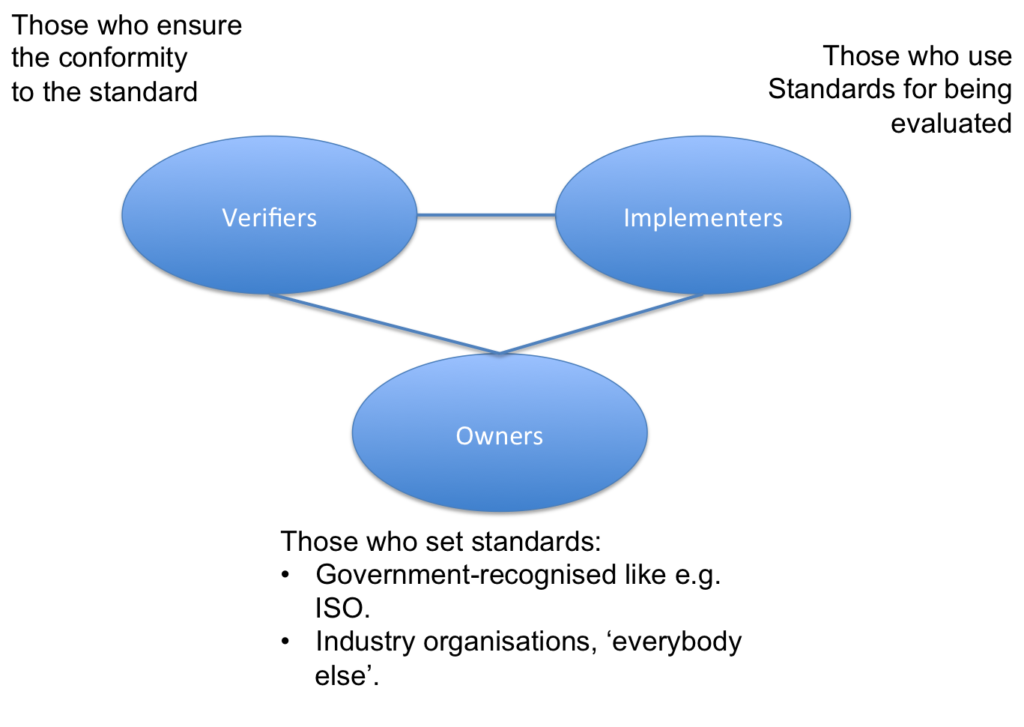
Co-written with: Anne Gillespie, Textile Exchange
This article appeared in edited format in Ecotextile News April/May 2016 Edition
One clear definition of a standard is (Source):
“A rule (i.e. an explicitly formulated piece of text) for common and voluntary use, decided by one or several people or organisations.”
Of the close to 500 eco-labels that exist worldwide, just over 100 apply to textiles, according to the Eco Label Index. Behind each label is, or should be, a standard that backs up the claim being made.
Given the prevalence of standards, the following questions arise:
- Why do standards exist?
- What value do they deliver?
- What are their limitations?
- What is ‘best practice’ for standards, their development process?
- What about the proliferation of standards?
Standards: Why and what for?
Standards offer different value for different players. For brands, they are a means to communicate and ensure that their expectations are being met. For suppliers, they provide a way to demonstrate that they are following best practices.
At a very basic level, standards are a risk and quality management tool:
- They give brands a way to establish requirements throughout their whole supply chain, even when they do not know each individual unit within their supply chain.
- They help brands and supply chains a tool to reduce risk – and add value – to individual products and company operations.
At an operational level, standards trigger the realisation of efficiencies by scaling out common practices that, if done well, shift industry best practices towards a new baseline by:
- Setting clear and consistent expectations across the industry.
- Creating market consequences for bad practices (‘non-compliance’).
- Recognising and rewarding best practices
On a consumer level, standards give consumers a fast and efficient way to make informed choices about their purchases.
Standards: Limitations
There are important limitations to standards and their respective certifications. The most critical of which probably is that a standard can never be a guarantee!
A strong verification process will back up a good standard, with the strongest being certification by independent, professional third parties. However any audit is always just a snapshot in time, and will not be able to evaluate all of the activities. For example, if we consider an audit to the Responsible Wool Standard, an auditor will visit a farm on a single day. During the audit he or she will talk to the farmer and workers, review documents; visit facilities, yards and pastures, and observe operations. Some farms cover tens of thousands of acres, and it will be impossible to see everything. Likewise, farmers carry out shearing, lambing and marking (castration, tail docking) at different times of the year, so an auditor can only witness one of these at best.
In all cases, the quality of the auditor plays a key role in determining how effective an audit is. Experience and expertise in both the industry and in auditing are critical, and the best standards will have a robust process in place to ensure consistent high quality. Use of professional accreditation bodies, which assess the performance of the certification bodies, usually according to ISO criteria, further helps to sustain best practise.
Standards & standard development: Best practice
Beyond their content, the quality of standards is most determined by the process of how they are developed. Having a robust, open, and transparent process ensures that the concerns of all interested and affected parties (stakeholders) are heard, represented and appropriately integrated into the standard.
Roles
In the implementation of standards, best practice is that there are separate roles between the
- Implementers (ie: organizations being evaluated),
- Verifiers (i.e.: those who ensure the conformity to the standard, such as certification bodies) and
- Owners of the standard (i.e. those responsible for the development, revision and maintenance of the standard).
The following figure illustrates the relationship between different stakeholder roles.

These requirements can be further complemented through the following characteristics1 that represent best practice in standard development:
-
Open
Meeting:
All may participate in the standards development process. -
Consensus,
Impartiality:
All interests are discussed and agreement is found. No one single party dominates the process. -
Due
Process:
Clearly structured, transparent process, where balloting and an appeals process may be used to find resolution. Results and progress is documented and achieved in good faith and truthfully.
Content
In addition to the process of development, there are a number of principles that need to be respected to ensure effectiveness:
-
Objectives:
The objectives the standard is aiming to achieve are clearly defined and communicated. These objectives must be unique and sufficiently distinct from any other standard in existence.
All decisions during creation and specification of the standard must therefore be in line with the objectives put forward. The objectives should have both aspirational as well as basic compliance level aspects. -
Progress:
The standards allow for measurable results so as to track progress towards the objectives as defined above. These should contribute to improvements in the standard as part of a regular review and revision process. -
Fit
for purpose
A standard address the most impactful steps towards achieving the objectives. All requirements outlined in a standard only contribute to achieving the objectives, in accordance to with the best possible scientific consensus and valid international norms and applicable legislation. Application is, where and if necessary, adapted to local context in a specific geography of implementation. -
Stringency
The standard is written and structured in a way that is both logical and well understandable for implementers, as well as fully aligned with delivering quality outcomes towards the identified objectives. There are both aspirational as well as basic compliance performance levels, all of which can be suitable and accurately measured and reported against. -
Accessibility
The standard does not introduce barriers to implementation, such as overly burdensome requirements or expensive verification costs. Training and support is given to facilitate implementation.
Standarditis: A standard for everything – or is more better?
It has been argued that the proliferation of standards creates confusion among consumers. However, studies show that children still too young to read already recognise corporate logos, and it is estimated that an average American sees as much as 16,000 brands every single day. (Source)
So the number of standards logos may therefore not be the issue: if we look at the standards as a shorthand way to communicate the sustainability values to consumers, then as long as the standards backing them up are valid, it might not be that bad after all.
However there can be issues if we look further upstream and consider the impact of such a number of different standards on the supply chain: when a single supplier is required to be audited to multiple, overlapping and/or conflicting, standards, it more often than not is a source of cost in terms of time, money and productivity, as well as frustration.
Standard owners should work address this in one of several ways:
-
Avoid
Duplication
Before developing a new standard, there should be a careful review of existing ones, and only proceed if there is a genuine need. -
Equivalency
Recognition
Recognise other certifications where possible. -
Convergence:
Work with other standard holders to look for ways of convergence
The Value of Standards for Sustainability
What can standards offer specifically in the area of sustainability?
Above and beyond the characteristics and advantages outlined in this article so far, when it comes sustainability, standards have an important role to play, as proven by organisations such as ISEAL, but also the work by the Textile Exchange. For sustainability, standards create differentiating value:
- Common Language:
A standard introduces a set of specialised vocabulary for the standard’s area of expertise. As a standard is scaled out, implemented, and used in labelling of end-consumer products, the common vocabulary gradually supports the alignment of discussions and implementation practice. - Comparability:
Standards allow producers, brands and end-consumer to compare credentials across the board. For a brand that would be those of the suppliers they are working with (B2B), and for the end-consumer those of the products they buy (B2C). - Aspirations Benchmark:
A standard outlines an aspiration that is achievable but also pushes for improvement. It therefore encourages a ‘race to the top’ and to separates the wheat from the chaff. - Efficiencies:
A wide adoption of consistent requirements across the supply chain is especially interesting in sustainability terms, as it mitigates the increased costs of becoming certified by spreading them over more products. Further, alignment across multiple supply chain partners reduces the complexity created by multiple measurement systems, which again result in efficiencies.
In summary, standards offer different value for different players. If they follow best practice, they are a tool for brands and the supply chain not only to reduce risk, but to communicate requirements clearly and – most importantly – add value.

